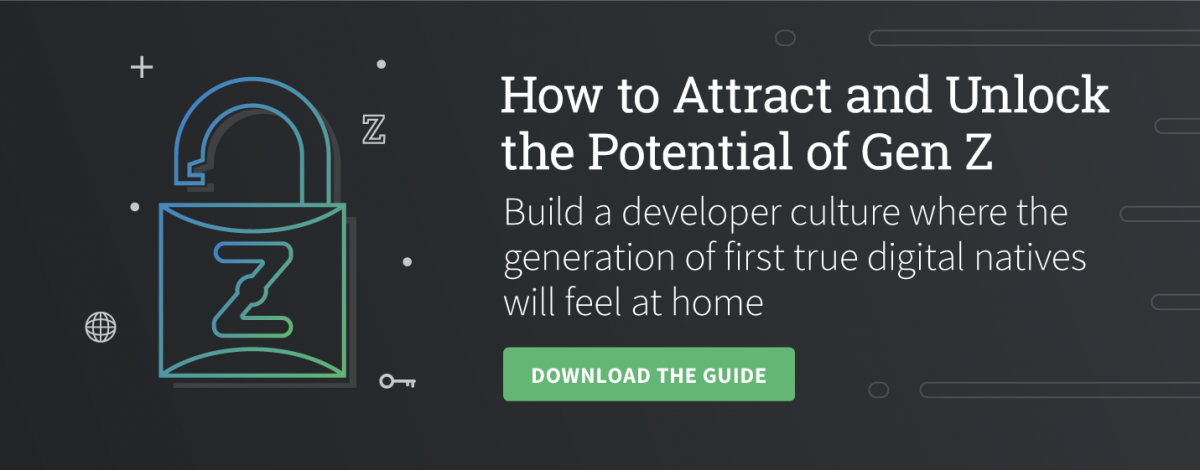Around the world, the innovation economy is moving faster than we can understand. As technology becomes a core focus for every type of organization, we’re seeing increased competition in reaching a finite talent supply. At the same time, booming remote work cultures mean that developers can work for companies from any location. To keep up, recruiters need to find the best developers where they are and offer compelling reasons to choose their organization over others.
Behind the scenes of this talent-driven economy is an invisible force that the World Economic Forum calls the Fourth Industrial Revolution.
“It is characterized by a range of new technologies that are fusing the physical, digital and biological worlds, impacting all disciplines, economies and industries, and even challenging ideas about what it means to be human,” explains professor Klaus Schwab, founder and executive chairman at the World Economic Forum.
This is a time of great promise and great peril, Schwab elaborates. He explains that “organizations might be unable to adapt” to this shifting power, which could result in growing inequality and fragmented societies.
Developers are building the heart, soul, and intellectual backbone of our world—which is why companies need to hire for passion
Recruiters have a hand in writing the story of how a business will perform 10, 20, and even 100 years from now. The people they hire are ultimately responsible for creating the technologies that power how companies run behind the scenes. Every decision that human beings make creates ripple effects into the future that we’re building. The world we want to exist is in our hands, at our fingertips. It exists in the code we write, the teams we build, and the camaraderie we establish.
Every developer your organization hires has the potential to transform the trajectory of your business over the short- and long-term. The key to reaching the best developers in 2020 and beyond is through the value proposition that you communicate to potential hires. This is also known as a company’s employer brand.
Stack Overflow recently conducted its latest survey that connects macro-trends to everyday micro-decisions that developers make when choosing jobs. The survey is now in its ninth year, collecting the perspectives of 90,000 people to make it the biggest survey of developers in the world.
From this data, we’ve identified exactly how you can communicate your best story as an employer that’s leading the way in the Fourth Industrial Revolution.
Here are four tips to keep in mind when building your global recruiting presence.
Attract talent that wants to create the future fabric of our world with a magnetic employer brand
Get developers excited about your technology
The best developers are lifelong aficionados of their craft and are always seeking to level up their capabilities by learning and expanding their skill sets in useful programming languages. These programming languages not only form the foundation of the work that developers do everyday, they are also the basis for online support groups and developer communities all over the world. That’s why developers tend to have strong preferences regarding the code bases that they choose to learn; these learning decisions impact their career trajectories for years to come.
For context to help drive your communication strategy, developers identified the following as the top three loved and dreaded programming languages, web frameworks, and tools that they’ve come across in their careers. If you’re curious, you can see the complete list of rankings here.
Loved and dreaded programming languages
LovedDreadedRust - 83.5%VBA - 75.2%Python - 73.1%Objective-C - 68.7%TypeScript 73.1%Assembly - 64.4%
Loved and dreaded web frameworks
LovedDreadedReact.js - 74.5%Drupal - 69.6%Vue.js - 73.6%jQuery - 54.7%Express - 68.3%Ruby on Rails - 42.9%
Other frameworks, libraries, and tools
LovedDreaded.NET Core - 77.2%Chef - 66.7%Torch/PyTorch - 77.1%Cordova - 63.3%Flutter - 75.4%Puppet - 61.8%
What these findings reveal is a tendency for developers to be selective about the ways they spend their workdays. If your company offers the opportunity for engineers to level-up their craft with a loved programming language or framework, make this known. In qualitative interviews outside of this survey, we’ve found that developers want to see what they’re going to build. Be intentional about what you’re building and let the team’s current projects speak for themselves.
The story of your technology stack is an untapped force that can simplify your pitch.
Share a preview into your culture
When choosing whether to pursue and accept a new role, high-performing developers seek out more than salary, benefits, and office perks. These individuals want to surround themselves with fellow brilliant people. They care about people just as much as they care about code.
Our developer survey validates this finding: “office environment and company culture” ranks #1 as the most important job factor in the United States (52.5%). Languages, frameworks, and other technologies rank #2 (50.6%).
After all, it’s the people—not the tech—that drive whether developers will be successful in their role. In our survey, developers in the United States rated the following as being the greatest challenges to productivity:
Greatest challenges to productivity
1Distracting work environment - 41.8%2Meetings - 36.6%3Being tasked with non-development work - 36.5%4Not enough people for the workload - 33.6%5Lack of support from management - 26.6%
You can see the comprehensive list here.
If you’re part of a recruiting team, you can take these steps to give developers an authentic preview of their future work environment and team:
- Conduct and share video interviews with current teammates
- In job descriptions, provide a tangible breakdown of how someone in a role will spend their day
- Offer up the opportunity for candidates to shadow a development team as part of the interview process
- Pair each candidate with an experienced teammate for a video interview session, for an off-the-record conversation
- Encourage team members to write blog posts and speak at conferences about what it’s like to work at your company
As a recruiter, you’re a facilitator and connector. Top developers are trained skeptics by trade and know how to weed out false promises. Provide an authentic as possible view into what life at your company is like. Share why teammates feel happy, healthy, productive, and fulfilled.
Enable lifelong learning and growth
For passionate developers, coding is more than a job. It’s a way of life. Our survey found that 80% of developers work on code outside of work as a hobby.
That’s why it’s important for your company to be vocal in its stance towards lifelong learning. Does your company offer the following:
- Designated time on the job for team members to tinker (i.e. 20% time)
- An education stipend
- Online coursework
- Structured mentorship opportunities
- On-the-job training
- Hackathons or online coding opportunities
Do you designate time on the job for team members to tinker? Does your company offer an education stipend or access to online coursework? Do you provide structured mentorship opportunities to help encourage growth? Does your company contribute to open source programs?
If you do, make sure that this information is front-and-center. Developers actively invest in their learning and will appreciate the opportunity to advance their education on the job.
In our survey, professional developers shared that lifelong learning is an important part of their careers, with almost 90% of all developers saying that they have taught themselves a new language, framework, or tool without taking a formal course.
- 60% say that they have taken a course in programming or software development
- 53% have participated in a hackathon or online coding competition
- 44% say that they have received on-the-job training in software development
- 43% have contributed to open source software
Given past years’ trends, we anticipate that these numbers will increase in the coming years with Gen Z— one of history’s largest generational cohorts— entering the workforce. To stand out, top employers communicate a commitment to lifelong learning on the job early on in the recruiting process.
Tell your story with consistent outreach to developers
One of the most important steps that you can take as an employer is to maintain a continuous line of communication with candidates in your pipeline. Someone who you reject for a management role could become an exceptional director down the road, for instance.
You never know where people are going to end up in life. But you’ll want to stay in touch with those who express interest in your organization. Keep in mind that it may take several years to establish an ideal fit with your company. Here are some steps that you can take to maintain a continuous line of communication:
- Encourage applicants to sign up to receive updates to developer job listings. Continue to reinforce the details listed in the tips above and ensure that you communicate expectations around salary, tech stack changes, developments in global remote work policies, and culture. Over time, subscribers to your job notification lists will get to know your culture. Any one detail has the potential to be a persuading factor in encouraging employees to take the leap. If you’re interested in further reading to craft thorough job listings, take a look at this article.
- Create a library of employer branding content. Build out a mix of evergreen videos, articles, team profiles, and resources about your company. You can use these on social media to educate audiences about your technical teams for years to come. By sharing this content consistently, you’ll build an engaged follower base along with an inbound pipeline of prospective job applicants. For inspiration, check out this collection of 10 brilliant employer branding hubs that we love.
- Develop a presence in your local tech community to host or participate in events. Talk to your development team to see who might be interested in speaking at conferences. Ask people who are currently on the conference circuit to mention how to follow open jobs at your company. No matter your strategy—and whether or not you have a budget to support a formal events program— make sure that you’re developing a strong personal rapport with people. Show developers that your company values its employees and cares about the career trajectory of your engineering team.
Final thoughts
As humanity takes its next step forward into an exciting—but uncertain—future, Schwab calls for leaders and citizens to “together shape a future that works for all by putting people first, empowering them, and constantly reminding ourselves that all of these new technologies are first and foremost tools made by people for people.”
Recruiters are in a powerful match-making role, identifying the developers who are coding the technology for the world’s future. First impressions matter, and your employer brand is an important tool for establishing the right tone—especially since the world is changing faster than human minds can keep up with.
“The Fourth Industrial Revolution is within the control of all of us as long as we are able to collaborate across geographies, sectors and disciplines to grasp the opportunities it presents,” writes Schwab in his new book, The Fourth Industrial Revolution.
At the end of the day, what developers value is substance and authenticity. Making a career decision is never easy, especially for people who are happy at their jobs or evaluating multiple offers. The most important thing to communicate with your employer brand is that you take each candidate seriously and you care that all prospective hires make an informed decision. By doing this and conveying a genuine employer brand, you'll give your organization the invaluable advantage of building and retaining the strongest team to carry it into the future.

